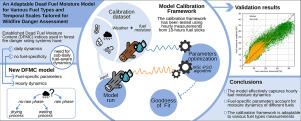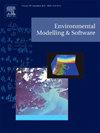为野火危险评估量身定制的适用于各种燃料类型和时间尺度的死燃料湿度模型
IF 4.8
2区 环境科学与生态学
Q1 COMPUTER SCIENCE, INTERDISCIPLINARY APPLICATIONS
引用次数: 0
摘要
估算枯燃料水分含量(DFMC)对野火风险管理至关重要,是森林火险评级系统和野火模拟模型的关键组成部分。受当地天气和燃料特性的影响,死燃料水分含量每天都有不同程度的波动。这就需要建立能提供次日燃料湿度条件的模型,以改善野外火险管理。许多森林火险等级系统通常依赖于每日燃料湿度模型,而这些模型会忽略当地的燃料特征,从而影响野火管理。所提出的半经验参数化 DFMC 模型通过提供每小时死燃料湿度动态来解决这些问题,并提供特定参数以考虑当地燃料特性。采用粒子群优化算法提出了一个校准框架。在本研究中,利用每小时 10 小时的燃料棒测量结果对校准框架进行了测试。在森林火险等级系统中实施该模型将提高森林火险状况的详细程度,从而推进野外火险管理。本文章由计算机程序翻译,如有差异,请以英文原文为准。

An adaptable dead fuel moisture model for various fuel types and temporal scales tailored for wildfire danger assessment
Estimating the Dead Fuel Moisture Content (DFMC) is crucial in wildfire risk management, representing a key component in forest fire danger rating systems and wildfire simulation models. DFMC fluctuates sub-daily and spatially, influenced by local weather and fuel characteristics. This necessitates models that provide sub-daily fuel moisture conditions for improving wildfire risk management. Many forest fire danger rating systems typically rely on daily fuel moisture models that overlook local fuel characteristics, with consequent impact on wildfire management. The semi-empirical parametric DFMC model proposed addresses these issues by providing hourly dead fuel moisture dynamics, with specific parameters to consider local fuel characteristics. A calibration framework is proposed by adopting Particle Swarm Optimization-type algorithm. In the present study, the calibration framework has been tested by using hourly 10-h fuel sticks measurements. Implementing this model in forest fire danger rating systems would enhance detail in forest fire danger conditions, advancing wildfire risk management.
求助全文
通过发布文献求助,成功后即可免费获取论文全文。
去求助
来源期刊

Environmental Modelling & Software
工程技术-工程:环境
CiteScore
9.30
自引率
8.20%
发文量
241
审稿时长
60 days
期刊介绍:
Environmental Modelling & Software publishes contributions, in the form of research articles, reviews and short communications, on recent advances in environmental modelling and/or software. The aim is to improve our capacity to represent, understand, predict or manage the behaviour of environmental systems at all practical scales, and to communicate those improvements to a wide scientific and professional audience.
 求助内容:
求助内容: 应助结果提醒方式:
应助结果提醒方式:


